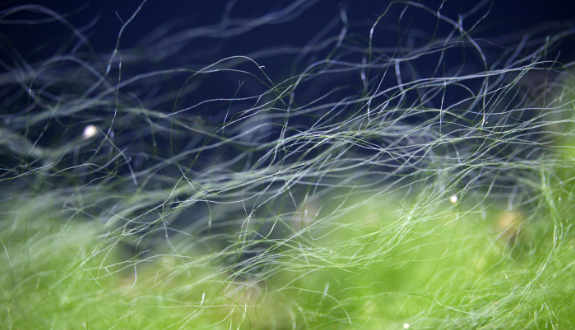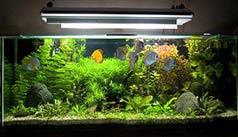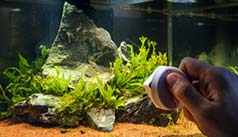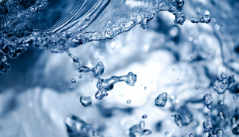

Our other guides (click on the thumbnail)
General
There you go! The dreaded problem is here: your aquarium is overrun with algae!
First of all, you should know that algae are present in all aquariums: it's a natural phenomenon. Algae such as filamentous algae, when they are in small quantities, even attest to a good balance in your aquarium's ecosystem. Moreover, they bring a little touch of authenticity and naturalness to your tank. Finally, they can be beneficial to a certain number of species of fish and invertebrates (snail, shrimp...).
On the other hand, it is when algae invade the aquarium that there is a problem. Indeed, algae, in addition to being unsightly, can smother your plants and become embedded in your decor.
The presence of algae is inevitable in any aquarium that starts (cycling phase). Why is this? Your plants, freshly installed, need time to take root and start growing. The same is not true for algae, which are much quicker to take advantage of the nutrients present in the water. A mistake would be to start all over again when the first algae appear by changing the water completely. This would actually only delay the installation of the plants and feed the algae even more. Let the cycle happen naturally. Remember: a beautiful aquarium with abundant and healthy vegetation, with beautiful and healthy fish, takes time, and that is counted in months, not days!
In a well-established aquarium (several months after it is put in the water), the challenge will be to avoid the excessive appearance of algae. For this, the aquarium must be well balanced and clean, which requires a number of elements:
the presence of many living plants, which will consume part of the nutrients present in the water. Plants with fast growth are particularly recommended (Cabomba, Elodea, Ceratophyllum...),
regular and sufficient water changes giving a good water quality,
the presence of small friendly helpers: groundfish, snails, viviparous fish, shrimps... But don't forget that they are not tools, they are living beings that have their own needs!
an adapted lighting (on average 1 Watt for 2 liters of water, or between 20 and 35 Lumens per liter of water). Change of fluorescent tubes at least once a year.
Any algae problem is due to an imbalance in the aquarium ecosystem. The challenge will therefore be to identify this imbalance in order to treat it. To do this, start by testing the parameters of your water, especially nitrates, phosphates and iron. Too high a level in these parameters can quickly explain the presence of algae. Then pull up the thread of this defective parameter to identify the problem and solve it. For example:
Nitrates (NO3) - normal level: between 20 and 25 mg/l. Too much nitrates: is my aquarium overpopulated? Am I feeding my fish too much? Is my filter powerful enough? Are the water changes regular and sufficient?
Phosphates (PO4) - normal rate: between 0.01 and 0.02 mg/l. Too much phosphate: is my tap water already too full of phosphates? Test your tap water: if the level is too high, use a phosphate-free filter mass (resin).
NO3/PO4 balance: 10 mg/l NO3 for 1 mg/l PO4.
Iron (Fe) - normal level: between 0.05 and 0.1 mg/l. Too much iron: is my fertilizer intake too high?
Numerous anti-algae products are sold commercially. Be careful with the use of these chemicals, which often cause more problems than they solve. To eliminate algae, opt instead for natural solutions without damaging the ecosystem of your aquarium. It takes time (count in weeks) and effort (you'll often have your hands in the water) but it's much better to do it this way. Anti-algae products should only be the last resort, when everything has been tried before.
The different kinds of algae
Filamentous algaes

Filamentous algae are very common. They are in the form of long green filaments that attach themselves to the decoration, the ground or the leaves of plants.
This type of algae is an integral part of a well-balanced aquarium: if they are present in small quantities, all is well! Nevertheless, remain vigilant and remove by hand (or by rolling them up with a fork or a fondue pick) the algae that are beginning to spread. Otherwise you may find yourself quickly overgrown.
If their presence becomes a problem, it probably comes from a last adjustment to be made: too much light (too powerful LED ramp, faulty neon tubes, too long lighting time), too many nutrients (fertilizers), polluted water (overpopulation, overfeeding...), not enough plants...
On the side of the auxiliaries who can help you, count on the appetite of Ancistrus and Planorbis snails. However, these animals only consume young algae shoots and will neglect those larger than 5 mm. It is therefore useless to count on them in a tank already largely invaded by filamentous algae: they will not be of any help.
Brown algae
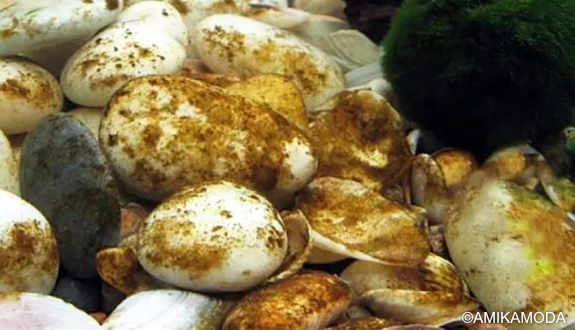
They are often the first to appear in a new aquarium. Don't panic: they are part of the natural starting process of the aquarium and will disappear within a few weeks if the biotope is well balanced.
Ancistrus are very fond of this type of algae and they will be great allies. However, like any animal, it too has needs that must be respected (to learn more about the Ancistrus, see our fact sheet).
Green algae
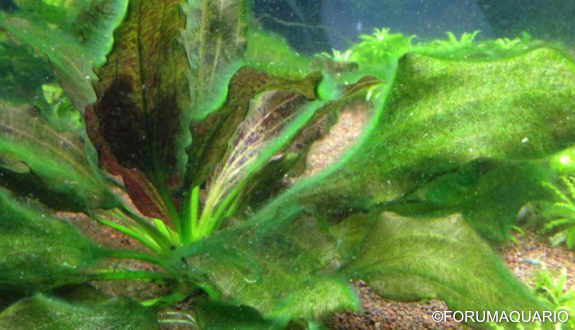
These varied algae can be fixed on the ground, on the decoration or on the plants.
As for the algae on the ground, they are easily recognizable: they form small mats of short green filaments with a cloudy appearance. There are several possible causes: nutrient-rich soil, too much light or too much CO2 diffusion. Siphon off the tufts and focus on the installation of fast-growing plants. Indeed, these plants are nutrient hungry and will consume a large part of what the algae need. Also turn down the intensity (not the duration) of your lighting. This should be enough to stop these green algae.
For those that attach themselves to the leaves of plants, they form like a 3 mm down covering the entire leaf. This deprives the leaf of light and suffocates it completely, which eventually dooms the whole plant. This type of algae develops mainly because of polluted water (nitrates and phosphates). To overcome this problem, change the water more frequently, or adjust the amount of water to be renewed. Cut the leaves that are completely invaded.
Green algae growing on the decor (rocks, roots...) are longer and can form clumps of up to 3 cm. They are due to heavy water pollution under strong lighting. Pick up as many clumps as possible by hand, and change the water in the aquarium more often (or adjust the amount of water to renew). With patience, you should get rid of these algae.
Finally, you will see green algae that form like scabs on the decor. This is a good sign: their presence indicates a good balance of the aquarium. The growth is slow and their development is not a problem.
As far as helpers are concerned, viviparous fish such as Molly, Xipho, Platy and Guppy consume green algae and will help you to limit their proliferation. But once again, don't count on them as a miracle solution! Finding the cause and balancing your aquarium is the right solution to algae problems.
Black algae
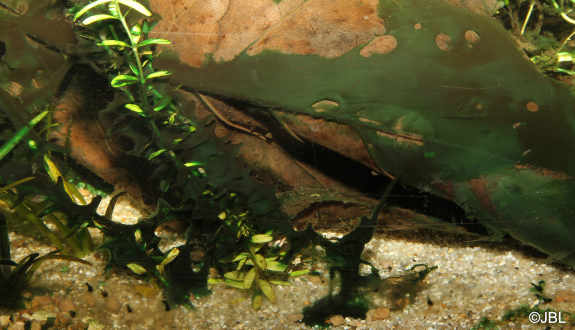
Formerly called "blue algae", these algae are not actually blue algae. In fact, they are cyanobacteria that form filaments like algae. The viscous mat they form usually settles on the ground and has colors ranging from green to dark red.
There is no doubt about their origin: a strong pollution of the water (imbalance in nitrates and phosphates), to which is added a sudden change of parameter, such as a change of lighting or a treatment with copper for example. They can also be caused by overfeeding, especially of protein-rich foods. In some cases (rarer), they appear for no reason even in a healthy and well-balanced aquarium!
Eliminate black algae by siphoning them off regularly and improving the water quality of your aquarium (more frequent and consistent water changes).
Fish and snails do not eat cyanobacteria because they can be toxic. Commercially available anti-algae products also have no effect on this type of algae.
Black beard algae (beard algae)
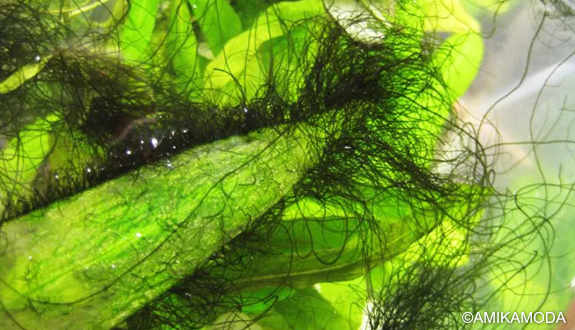
Here are the most dreaded algae in aquariums: beard algae. They come in the form of small black tufts about 1 cm high. Easy to recognize, they develop first on the edge of the leaves and then end up attacking the decoration. Without any measure to counter them, they will invade all the space they have at their disposal. In addition, they are solidly clinging to their support.
Their origin lies in poor water quality, especially in the case of a high concentration of nitrates (NO3). Other water parameters can favour their appearance, such as a pH above 7.5, a carbonate hardness above 13°KH and strong water mixing.
Not many solutions to this type of algae, when they appear, it is extremely difficult to get rid of them. Some chemicals can temporarily remove them, but unfortunately there is nothing effective in the long term. Natural allies such as groundfish do not eat them.
The improvement of water quality, coupled with manual removal and the regular release of CO2 should improve the situation. If possible (depending on your population) lower your hardness by using osmosis water. Cutting off the affected leaves is mandatory because it is impossible to pull out the beard algae without damaging the leaf that serves as a support.
